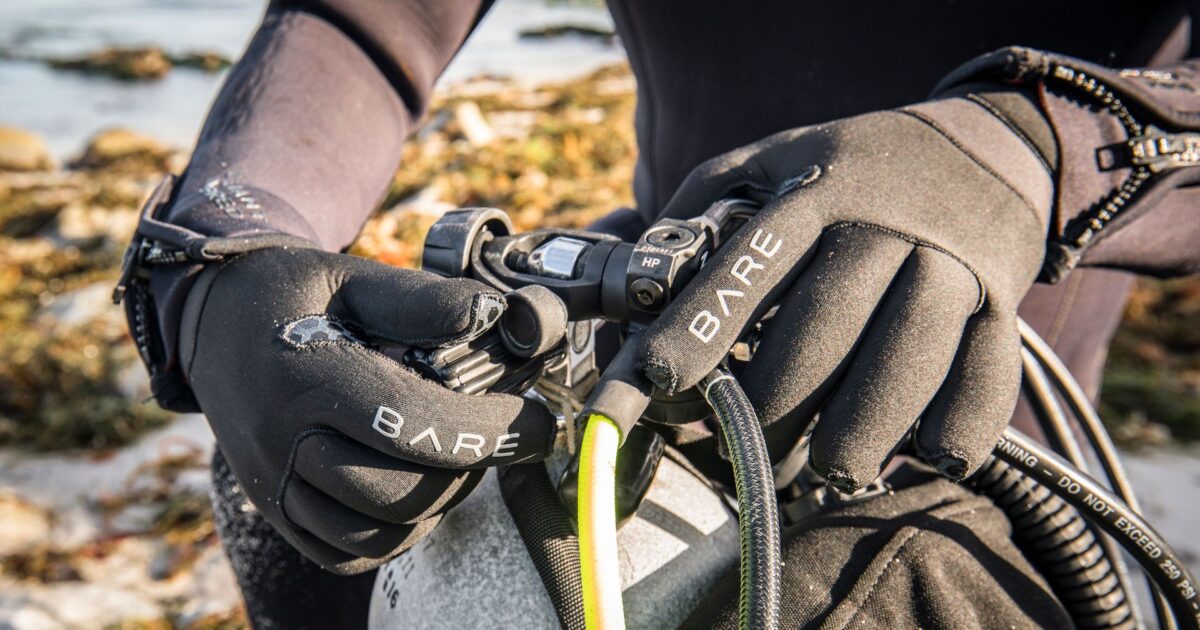Nothing saps the fun out of an experience like getting cold. Whether the weather’s bad, you took an unexpected swim, or your gear just isn’t up to snuff, staying warm is key. And one of the best ways to ensure a safe, enjoyable, warm adventure is to come prepared with reliable equipment and a hearty attitude.
Warmth, however, is a relative idea, and it’s possible to think that 38 degree Fahrenheit lake water is warm, if you come prepared with the correct combination of wet/drysuit tech and proper insulation layers.
Most conversations about warmth retention almost always start with the avoidance of getting wet. But as divers, getting wet is a given. So knowing that you’ll be getting wet, and staying wet, what are some useful, actionable tips for keeping warm?
1) Glove and Bootie Up
There are many fundamental ways to keep your hands and feet warm, but the best head start you can give yourself is to don a pair of neoprene gloves and booties. Some drysuits have built-in hand and foot chambers, so the neoprene layers won’t be necessary but even so, it’s still nice to wear a pair of insulating synthetic glove liners for these situations.
2) Keep Moving
One of the best ways to rapidly lose body heat and succumb to the shivers is to stop moving. Maintaining blood flow and heightened cardiovascular activity are two of the top things you can do, even in otherwise frigid circumstances, to keep warm.
If you get cold while diving, try to keep moving as much as possible. Remember to assess your oxygen levels frequently—you’ll be burning more of it as you work to reclaim body heat and blood flow. If you find yourself shivering through decompression stops, try swimming slowly in circles at the same relative depth. In the diving-specific context, your best option is to avoid this situation by wearing a great wetsuit or drysuit!
Generally speaking, if you’re in danger of becoming hypothermic—above water or below—it’s a good idea to get your blood pumping.
3) Insulate Your Core
The core is what generates most of our body heat and heating the core properly makes it much easier to heat up your hands and feet. To ensure the core is able to pump warmth to the outer extremities, don a wet/drysuit that meets minimum mil/temp requirements for the water you’re diving in. If donning a drysuit, be sure to wear insulating layers to stay warm.
Pro Tip: It’s always better to be a little too warm than too cold, so err on the side of comfort and heat!
4) Wear A Hood!
An enormous amount of body heat escapes through your head. Oftentimes, cold hands and feet are merely symptoms of your core and head not having enough thermal insulation. What’s the answer? Wear a neoprene hood, or even two, if necessary. Likewise, if you have multiple wetsuits of minimal thickness (several 3mm, per se), then don’t be afraid to double up and wear two wetsuits to decrease your thermal exposure.
5) Upgrade to a Drysuit
Likewise, cut the problem off at the knee and simply upgrade to a drysuit. As the name suggests, a drysuit keeps your core completely dry, meaning that it doesn’t need to expend as much effort to heat the body as it would if fully saturated. You can still deploy neoprene gloves and booties to insulate your hands and feet, assuming your drysuit doesn’t integrate full hand and foot coverage.
6) The Next Level: Wear Dry Gloves
Perhaps the best and most complete way to keep your hands warm while diving is to bite the bullet and start diving with dry gloves. By interconnecting with your drysuit, the dry gloves form a complete unit that prevents your epidermis from being exposed to the cold. This option assumes that you’re diving in very cold environments and shouldn’t be necessary in most moderate-to-warm diving destinations.











